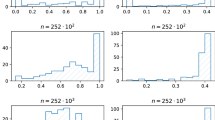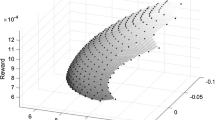Summary
The analysis of portfolio selection and capital market equilibrium problems involving multivariate lognormal distributions is impeded because this distribution is not closed under addition. To overcome this difficulty it is convenient to use the approximation that this sum is lognormal. Simulation and empirical tests and theoretical results lend support to the appropriateness of the approximation. This paper develops the necessary theory to determine whether such approximating functions are concave or at least quasiconcave and thus their analysis can proceed by standard methods. The characterizations, which involve explicit algebraic criteria related to the parameter values of the random variables and utility function, are evaluated using monthly and yearly stock price data.
Zusammenfassung
Die Analyse von Portfolio Selection Problemen sowie von Gleichgewichts-problemen wird beim Vorliegen logarithmisch-normaler Verteilungen dadurch erschwert, daß diese Klasse von Verteilungen nicht abgeschlossen gegenüber der Addition ist. Das Ersatzmodell, das man dadurch erhält, daß die Summe als logarithmisch-normalverteilt unterstellt wird, erweist sich jedoch als gute Approximation des ursprünglichen Problems, wie empirische sowie theoretische Ergebnisse zeigen. In der vorliegenden Arbeit wird untersucht, unter welchen Bedingungen die approximierende Zielfunktion konkav oder wenigstens quasikonkav ist, und daher das Ersatzproblem mit einem Standardverfahren der konkaven Programmierung gelöst werden kann. Es werden notwendige und hinreichende Bedingungen für die Quasikonkavität der approximierenden Funktion für verschiedene Parameterwerte der Verteilung und der Nutzenfunktion abgeleitet. Die Verwendung der erhaltenen Kriterien, die leicht nachzuprüfen sind, wird am Beispiel monatlicher und jährlicher Daten illustriert.
Similar content being viewed by others
References
Aitcheson, J., andJ.A.C. Brown: The Lognormal Distribution. University Press, Cambridge 1966.
Avriel, M., W.E. Diewert, S. Schaible andW.T. Ziemba: Introduction to Concave and Generalized Concave Functions. In: Generalized Concavity in Optimization and Economics, Academic Press, ed. by: Schaible, S. and W.T. Ziemba. New York 1981, 21–50.
Avriel, M., W.E. Diewert, S. Schaible andI. Zang: Generalized Concavity. Plenum Publishing Corporation, New York 1985.
Bawa, V.S., andL.M. Chakrin: Optimal Portfolio Choice and Equilibrium in a Lognormal Securities Market. In: TIMS Studies in the Management Sciences11, ed. by: E.J. Elton and M.J. Gruber, North Holland, Amsterdam 1979.
Bereanu, B.: Quasi-convexity, Strict Quasiconvexity and Pseudo-convexity of Composite Objective Functions. Rev. Francise Automat. Informat. Recherche Opŕationalle6, 1972, 15–26.
Crouzeix, J.P.: On Second Order Conditions for Quasiconvexity. Mathematical Programming18, 1980, 349–352.
Dexter, A.S., J.N.W. Yu andW.T. Ziemba: Portfolio Selection in a Lognormal Market when the Investor has a Power Utility Function: Computational Results. In: Stochastic Programming, Academie Press, ed. by: Dempster, M.A.H., New York 1980, 507–523.
Diewert, W.E., M. Avriel andI. Zang: Nine Kinds of Quasiconcavity and Concavity. J. of Economic Theory25, 1981, 397–420.
Gantmacher, F.R.: The Theory of Matrices I, Chelsea Publishing Company, New York 1959.
Greenberg, H.J., andW.P. Pierskalla: A Review of Quasi-convex Functions. Operations Research19, 1973, 1553–1570.
Hakansson, N.H.: On Optimal Myopic Portfolio Policies, With and Without Serial Correlation of Yields. J. of Business44, 1971, 324–334.
Hanoch, G., andH. Levy: The Efficiency Analysis of Choices Involving Risk. The Review of Economic Studies36, 1969, 335–346.
Kallberg, J.G., andW.T. Ziemba: Comparison of Alternative Utility Functions in Portfolio Selection Problems. Working Paper No. 609, University of British Columbia, 1978.
-: An Extended Frank-Wolfe Algorithm with Application to Portfolio Selection Problems. In: Recent Results in Stochastic Programming, ed. by: P. Kall and A. Prékopa, 179, Lecture Notes in Economics and Mathematical Systems, Springer Verlag 1980.
Lintner, J.: Equilibrium in a Random Walk and Lognormal Securities Market. Discussion Paper No. 235. Harvard Institute of Economic Research, Cambridge, Massachusetts 1972.
Mangasarian, O.L.: Nonlinear Programming. McGraw-Hill, New York 1969.
Markowitz, H.M.: Portfolio Selection. Yale University Press, New Haven 1959.
Newman, P.: Some Properties of Concave Functions. J. of Economic Theory1, 1969, 291–314.
Noble, B.: Applied Linear Algebra. Prentice-Hall, Englewood Cliffs, New Jersey 1969.
Ohlson, J.A., andW.T. Ziemba: Portfolio Selection in a Lognormal Market when the Investor has a Power Utility Function. J. of Financial and Quantitative Analysis11, 1976, 57–71.
Pratt, J.: Risk Aversion in the Small and in the Large. Econometrica32, 1964, 122–136.
Rosenberg, B.: The Behavior of Random Variables with Non-Stationary Variance and the Distribution of Security Prices. Unpublished Working Paper, University of California, Berkeley 1973.
Ross, S.A.: Mutual Fund Separation in Financial Theory: The Separating Distributions. J. of Economic Theory17, 1978, 254–286.
Schaible, S.: Quasi-convex Optimization in General Real Linear Spaces. Zeitschrift für Operations Research16, 1972, 205–213.
—: A Survey of Fractional Programming. In: Generalized Concavity in Optimization and Economics, Academic Press, ed. by: S. Schaible and W.T. Ziemba. New York 1981, 417–440.
Sharpe, W.F.: Portfolio Theory and Capital Markets. Prentice-Hall, Englewood Cliffs, N.J. 1970.
Ziemba, W.T.: Choosing Investment Portfolios when the Returns have Stable Distributions. In: Mathematical Programming in Theory and Practice, ed. by. P.L. Hammer and G. Zoutendijk, North Holland, Amsterdam 1974.
Author information
Authors and Affiliations
Rights and permissions
About this article
Cite this article
Schaible, S., Ziemba, W.T. Generalized concavity of a function in portfolio theory. Zeitschrift für Operations Research 29, 161–186 (1985). https://doi.org/10.1007/BF01920307
Received:
Revised:
Issue Date:
DOI: https://doi.org/10.1007/BF01920307




